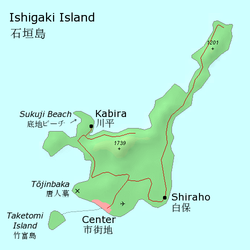| Sinomicrurus iwasakii | |
|---|---|
| Scientific classification | |
| Kingdom: | Animalia |
| Phylum: | Chordata |
| Class: | Reptilia |
| Order: | Squamata |
| Suborder: | Serpentes |
| Family: | Elapidae |
| Genus: | Sinomicrurus |
| Species: | S. iwasakii |
| Binomial name | |
| Sinomicrurus iwasakii (Maki, 1935) | |
 | |
 | |
| Synonyms [1] | |
| |
Sinomicrurus iwasakii, the Iwasaki's temperate Asian coralsnake, is a rare species of coral snake from the Ishigaki and Iriomote islands of the Yaeyama Group, Ryukyu Archipelago, Japan. [2] S. iwasakii belongs to the family Elapidae which also includes cobras and sea snakes.
Contents
The International Union for the Conservation of Nature (IUCN) Red List does not include S. iwasakii as a species despite species status as of 2021. [3] Other similar Sinomicrurus species are listed as "Unknown" conservation status.